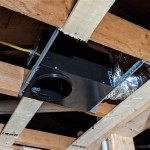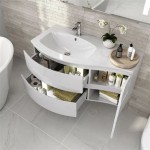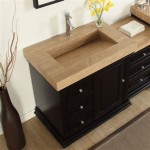Here is an article on fixing a bathroom sink faucet, written according to the provided specifications:
How To Fix a Bathroom Sink Faucet
Bathroom sink faucets, while generally durable, are susceptible to a variety of issues that can compromise their functionality and efficiency. Common problems include leaks, reduced water pressure, and difficulty controlling the water flow. Addressing these issues promptly not only prevents water wastage and potential water damage but also ensures the continued usability of the sink. A methodical approach to troubleshooting and repair is essential for effectively resolving these problems and restoring the faucet to its optimal working condition.
Before initiating any repair work, safety precautions are paramount. The first and most important step is to shut off the water supply to the faucet. This is typically achieved by closing the shut-off valves located directly beneath the sink. If these valves are inaccessible or malfunctioning, the main water supply to the entire house must be turned off. Once the water supply has been isolated, open the faucet to release any remaining water pressure in the lines. This reduces the risk of unexpected bursts of water during the repair process.
Gathering the necessary tools is the next critical step. The specific tools required will vary depending on the type of faucet and the nature of the problem. However, a basic toolkit should include an adjustable wrench, a Phillips head screwdriver, a flathead screwdriver, pliers, a basin wrench (for accessing hard-to-reach nuts), plumber's tape, and possibly a replacement cartridge or O-rings. Having these tools readily available streamlines the repair process and minimizes interruptions.
Identifying the specific type of faucet is crucial because different faucet types have different internal mechanisms and require different repair techniques. Common faucet types include compression faucets, ball faucets, cartridge faucets, and ceramic disc faucets. Compression faucets are the oldest type and are characterized by separate hot and cold water handles that require tightening to shut off the water flow. Ball faucets have a single handle that controls both the water temperature and flow. Cartridge faucets utilize a cartridge mechanism to control water flow, and ceramic disc faucets use two ceramic discs with precisely aligned openings to regulate water flow.
Addressing a Leaky Faucet
A leaky faucet is arguably the most common issue encountered with bathroom sinks. The source of the leak can vary, and pinpointing the exact cause is the first step in addressing the problem. Leaks can originate from the spout, the base of the faucet, or around the handles. Examining the faucet closely while it is running can often reveal the source of the leak.
For compression faucets, leaks are often caused by worn-out washers or O-rings. These components are responsible for creating a watertight seal when the faucet is closed. Over time, these parts can deteriorate due to constant exposure to water and pressure. To replace the washers or O-rings, the faucet handle must be disassembled. Start by removing the decorative cap on the handle, followed by the screw that secures the handle to the valve stem. Once the handle is removed, the valve stem can be unscrewed. Inside the valve stem, the worn washer or O-ring will be visible and can be replaced with a new one. Applying plumber's grease to the new washer or O-ring can help prevent future wear and tear.
Ball faucets are prone to leaks due to worn-out springs and rubber seats. These components are located within the faucet body and are responsible for controlling the water flow. To repair a leaky ball faucet, the entire faucet assembly must be disassembled. Begin by removing the handle and loosening the set screw. Next, unscrew the cap and collar. Inside, the ball assembly will be visible. Carefully remove the ball assembly and inspect the springs and rubber seats located beneath it. Replace any worn or damaged components with new ones. Reassemble the faucet in the reverse order, ensuring that all parts are properly aligned and tightened.
Cartridge faucets often leak due to a damaged or worn-out cartridge. The cartridge is a cylindrical component that controls the mixing of hot and cold water. To replace the cartridge, remove the handle and any decorative caps. Locate the retaining clip that secures the cartridge in place and remove it. Pull the old cartridge straight out of the faucet body. Before installing the new cartridge, ensure that it is the correct type and size for the faucet. Insert the new cartridge into the faucet body, making sure it is properly aligned. Replace the retaining clip and reassemble the handle.
Ceramic disc faucets are generally less prone to leaks than other faucet types, but they can still experience problems. Leaks in ceramic disc faucets are often caused by mineral buildup or debris that interferes with the proper sealing of the ceramic discs. To clean the ceramic discs, the faucet must be disassembled. Remove the handle and any decorative caps. Unscrew the cylinder that houses the ceramic discs. Carefully lift out the ceramic discs and clean them with a mild abrasive cleaner. Rinse the discs thoroughly and reassemble the faucet.
Addressing Reduced Water Pressure
Reduced water pressure in a bathroom sink faucet can be frustrating. Several factors can contribute to this issue, including clogged aerators, mineral buildup in the faucet body, and problems with the water supply lines. Identifying the root cause of the reduced water pressure is crucial for implementing the appropriate solution.
The aerator is a small screen located at the tip of the faucet spout. Its purpose is to mix air with the water stream, creating a smoother and more consistent flow. Over time, aerators can become clogged with mineral deposits and debris, restricting water flow and reducing water pressure. To clean the aerator, unscrew it from the faucet spout. Disassemble the aerator components and rinse them thoroughly under running water. Use a small brush or toothpick to remove any stubborn debris. Reassemble the aerator and screw it back onto the faucet spout.
Mineral buildup within the faucet body can also restrict water flow and reduce water pressure. To remove mineral buildup, the faucet must be disassembled. Remove the handle and any decorative caps. Disconnect the water supply lines from the faucet. Use a vinegar solution to soak the faucet components. Vinegar is a natural solvent that can dissolve mineral deposits. After soaking, rinse the faucet components thoroughly with water and reassemble the faucet.
In some cases, reduced water pressure may be caused by problems with the water supply lines. Kinks or blockages in the supply lines can restrict water flow to the faucet. Inspect the supply lines for any visible damage or obstructions. If the supply lines are kinked, straighten them out. If the supply lines are blocked, they may need to be replaced. Additionally, partially closed shut-off valves beneath the sink can also reduce water pressure. Ensure that the shut-off valves are fully open.
Addressing Difficulty Controlling Water Flow
Difficulty controlling the water flow in a bathroom sink faucet can manifest as erratic water flow, inconsistent temperature, or difficulty shutting off the water completely. These issues often stem from problems with the faucet's internal components, such as the cartridge, valve stem, or ceramic discs.
For cartridge faucets, difficulty controlling water flow is often caused by a damaged or worn-out cartridge. As previously described, the cartridge is responsible for mixing hot and cold water. If the cartridge is not functioning properly, the water temperature may be inconsistent, or the water flow may be erratic. To replace the cartridge, follow the steps outlined in the "Addressing a Leaky Faucet" section.
For compression faucets, difficulty controlling water flow can be caused by worn-out valve stems or damaged threads. The valve stem is responsible for controlling the flow of water through the faucet. If the valve stem is worn or the threads are damaged, it may be difficult to tighten the handle and shut off the water completely. To replace the valve stem, remove the handle and unscrew the old valve stem. Install a new valve stem of the correct size and type. Apply plumber's grease to the threads to ensure smooth operation.
For ceramic disc faucets, difficulty controlling water flow can be caused by misaligned or damaged ceramic discs. As previously described, the ceramic discs control the flow of water by aligning precisely with each other. If the discs are misaligned or damaged, the water flow may be erratic, or it may be difficult to shut off the water completely. To address this issue, disassemble the faucet and inspect the ceramic discs. Ensure that the discs are properly aligned and that there are no cracks or chips. If the discs are damaged, they will need to be replaced.
After completing any repair work, it is essential to test the faucet thoroughly. Turn on the water supply and check for any leaks. Observe the water flow and temperature to ensure that they are consistent and properly controlled. If any issues persist, re-examine the faucet and repeat the repair process as needed. Proper maintenance, such as regularly cleaning the aerator and checking for leaks, can help prevent future problems and extend the lifespan of the bathroom sink faucet.

Diy How To Replace A Bathroom Sink Faucet Remove Install

How To Replace A Bathroom Faucet Home Repair Tutor

Replacing A Bathroom Faucet Fine Homebuilding

Diy How To Replace A Bathroom Sink Faucet Remove Install

How To Remove And Install A Bathroom Faucet

How To Fix Loose Sink Faucet

How To Fix A Bathroom Faucet 14 Steps

Properly Fixing A Leaky Sink Faucet Wallside Windows

4 Easy Ways To Fix A Leaky Bathroom Sink Faucet With Double Handle

How To Fix A Leaky Bathroom Sink Faucet
Related Posts







